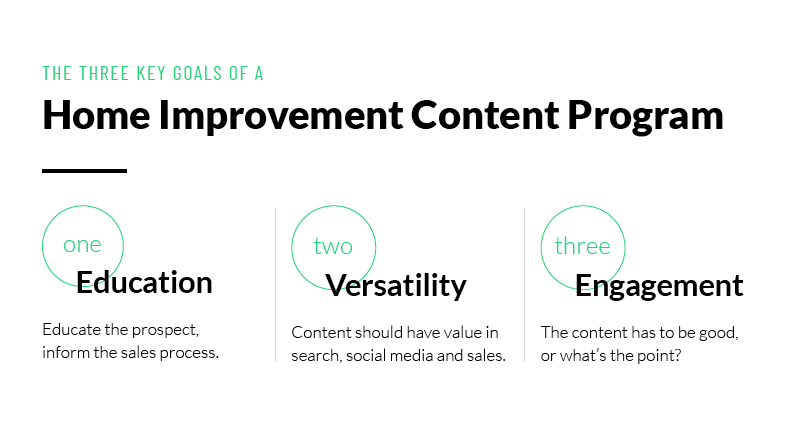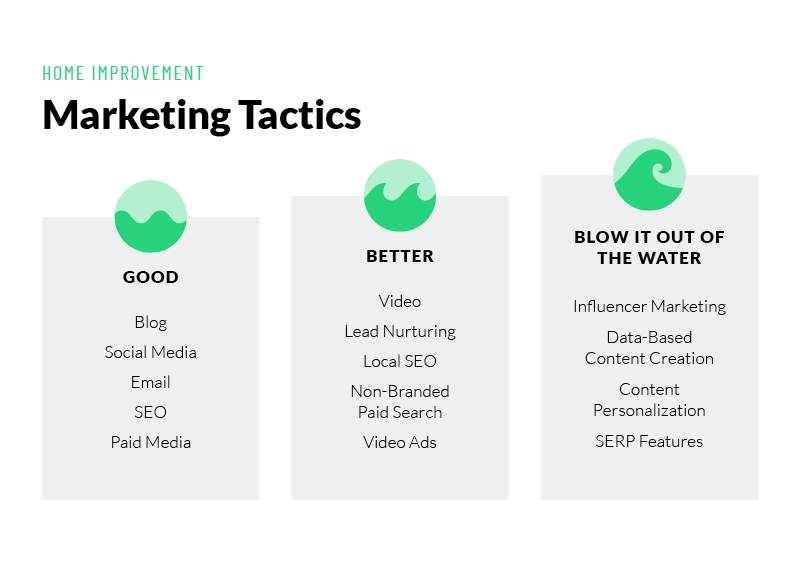
Home improvement marketing isn’t always a speedy proposition. It often takes seven or more touch points to create a customer.
The median household income in the U.S. is about $78,500 a year. Remodeling.net reports that the cost of an average home improvement job can run between $1,881 for a steel entry door replacement and over $282,000 for a master suite addition.
These are big-ticket items for most Americans that require significant consideration.
Another tricky issue to consider: consumer access to information, research, and branded content has made the sales funnel far less linear. A customer may jump like a cricket from funnel stage to funnel stage before eventually making a purchase.
Why? Because they can. There are a ton of resources available to consumers, and they’re all just a tap away.
As a home improvement marketer, you need to consider how you’re going to keep these savvy prospects interested in your brand.
Keeping the Home Improvement Customer Engaged

“One reason it takes a multitude of touches to generate a sales-ready lead is the sheer amount of information required to deem a lead sales-ready: Budget, Authority, Need, and Timeframe (BANT),” Fergal Glynn wrote in this Salesforce blog. “It often takes several touches for a consumer to make the choice to request information, and even more for marketing to gather the information needed to determine if a lead is ready to be passed to sales.”
This gets pricey. Businesses in the trades, notes marketing blogger Darren Slaughter, should expect to spend up to 15% of gross sales on marketing costs.
Content creation, particularly the kind that keeps a lead coming back for seven or more engagements before converting, can be time-consuming, expensive, or both.
Digital home improvement marketing needs to be as efficient as possible to mitigate the high cost of generating and nurturing leads. That won’t happen without the right plan.
Taking Home Improvement Marketing to the Next Level
A home improvement marketer must begin to identify as a publisher. Siloing creative strategies by channel is inefficient. All assets must also align with the needs of the sales team.
A home improvement marketing program should produce content assets with three specific goals in mind:

These are tall tasks, but they are not impossible. Like all successful home improvement projects, they simply take some planning, budgeting, creativity and measurement.
How Do We Create Efficient Home Improvement Marketing Programs?
“Renovation and remodeling stress takes on many forms,” writes Anne Reagan of Porch.com. “It might be the couple arguing over their kitchen layout at Ikea, an interior designer performing marital counseling over a husband and wife’s budget disagreements, a fight with the architect, contractor or flooring installer or spouses not seeing eye to eye on how a project should be completed.”
Calming the Customer
The Holmes and Rahe Stress Scale grades the degree of stress individuals feel in life and determines how likely that stress will make them physically ill. A score over 300 means you have an 80% chance of going to the doctor.
Let’s consider a home improvement project. You’re likely looking at a loan or refinancing (17 points), a change in living conditions (25) and a change in the number of arguments with a spouse (35). Just like that, the customer has added 77 points to their HRSS grade.
Your goal, then, as a home improvement marketer, is to calm the customer. Make the customer feel confident and secure in the decisions being made. You’re literally improving their health.
Sales-Focused: Eyes on Alignment
At the same time, you want all marketing assets to align with what’s being shared during the sales process. You do not want marketing material that confuses, contradicts, or clouds what your sales team is telling a customer.
On the contrary, you want your sales team to have the ability to take one of the assets you’ve created — a blog post, a slide from a sales deck, an interesting infographic — and use that asset to help inform their prospect.
Tying Customer Confidence and Sales Success Together Through Content

CEO/Entrepreneur Katlin Smith acknowledges that low prices, ease, and efficiency are top motivators for consumers choosing brands and products.
Home improvement projects, however, are often none of these things — so how do you ease the customer’s mind without straight-up lying?
Let’s look at the other motivators Smith identifies:
- Identity. “People make purchases that fit who they are or who they aspire to be (or both),” Smith writes. Do you know your customers? As a home improvement marketer, you should have reams of data about who buys from you, where they’re from, what they bought and so on. You should be able to pull together a comprehensive demographic snapshot of your customers. Based on this information, you are uniquely qualified to create buyer personas that will allow you to consider the reasons why your customers make the choices they do.
- Value. Home improvement products are not cheap, as noted above. But what can you tell a customer about the value they’re receiving? Don’t expect them to take your word for it — educate that customer on materials, installation, warranties, your employees, awards, expertise, etc. It’s fascinating stuff to someone with $20,000 on the line, and people want to be confident that they are getting a solid return on their investment.
- Experience. How will this home improvement project change their life? Think case studies — drawing on the experience of past customers who are thrilled about their new kitchen, roof, landscape, etc. allows the customer to envision the future of their investment with greater color and clarity.
- Community. All home improvement companies are, at least to some degree, local. Show your customer how you’re involved in the community. Charitable works and benevolent programs are great, but the case study-style content we mentioned above, as well as heavy emphasis on local roots, help build trust. A customer wants to know you’re not going anywhere.
- Quality. Highlighting quality allows a customer to feel more confident about decisions. Try not to fall into the jargon trap — you may know that the pewter oak 10mm x 7.5 inch x 47.25 inch waterproof laminate flooring is an awesome choice for the living room due to its moisture-proof HDF panel and anti-static surface, but the customer may be a little lost. Break down confusing jargon and explain what these terms mean — it’s a huge help, and provides a lot of content opportunities.
- Need. Need, essentially, combines all of the other motivators. A product or service that supports how the customer identifies, provides a high degree of value and offers the security of community and quality is a product or service that the customer will need. Content assets that support, enhance and illustrate your home improvement brand allow you to create this sense of need in both the digital nurturing program and the tangible sales process.
Home Improvement Marketing: Good, Better and Blow It Out of the Water

We now understand that a solid home improvement marketing plan must generate assets that both address specific customer concerns and align to the sales process. How does this translate to the work that you actually do? And how do you create assets that people will care about?
Let’s look at this through the lens of a good home improvement marketing program, a better home improvement marketing program, and a home improvement marketing program that will blow it out of the water.

1. Good Home Improvement Marketing
A good home improvement program embraces the inbound marketing triangle: a blog, a social media presence and an email program. We’ll also mix in a little SEO to enhance your content, and paid search to cover your bets.
- Blog: Produce educational content based on common questions your sales team hears from real customers as well as organic search data that shows you what a wider swath of people want to know. Keep it short and use various photos and design assets to facilitate easy scanning. Create a content calendar every quarter, and stick to it.
- Social Media: A robust Facebook and Instagram presence allows you to show off your work and drive targeted traffic. Use the great assets from your blog on Facebook and hire a professional photographer to get “after” photos from jobs well done for Instagram.
- Email: Distribute a monthly newsletter with your best blog posts. Keep in mind themes related to particular seasons or relevant industry questions or trends. People can opt-in from your website or when they request information from your business. Expect a high level of user attrition; once they complete the sales process, they probably won’t be as interested in your products anymore.
- SEO: Work with your developer or an SEO expert to make sure your website is technically sound and ready to be crawled by Google and other search engines. Track your progress to identify ways you can improve.
- Paid Search and Media: Running branded search ads ensures that whenever anyone looks for you in Google, you’re at the top of the page. Tap into Facebook’s powerful ad platform to reach a wide local audience, create engagement with posts on both platforms, and drive traffic back to your site. Remarketing campaigns and working with custom audiences make your investment more efficient.
2. Better Home Improvement Marketing
Better home improvement marketing includes everything you’re doing in the “Good” stage, but taking it all a bit further.
- Video: Create DIY videos using your phone and a tripod on the job and around the office in order to show off work and answer questions. Share these videos to YouTube and Facebook channels and embed them on your website. The first few will be a little rough, but don’t worry — you’ll get better. Keep it short, keep it smooth, and be authentic.
- Lead Nurturing: Work with your sales team to build out an automated email program that all customer prospects begin to receive once they enter your CRM. This will take some planning and tech work, but once someone requests more information about your products or services, they will begin to receive a smooth cadence of email messages that — based on how they engage (or don’t) — determine what the next, best message will be. This will really narrow the way you approach your content calendar, as well.
- Local SEO: In 2019, Google saw 350 times more searches for the keywords “local” and “near me” than in 2009. Build specific pages for your website around the areas you serve and the services you provide. Additionally, spend more time identifying directories and review sites where you can claim your business, fill out profiles with accurate information and respond to any comments made about your work.
- Non-Branded Paid Search: Increase your search investment to compete for a broader range of terms. Create unique landing pages that offer a cohesive experience for users who click on your ads. Users will enter the lead nurturing program with unique welcome messages based on their interests once they fill out the form on the landing page, and the content they receive will be tailored to their preferences.
- Video Ads: Using stock footage and some of the video you’ve shot yourself, make short :06, :15, and :30-second ads for your business that you can use on YouTube. This dovetails nicely with paid search campaigns, since YouTube — a Google product — can be tied into the search engine’s knowledge of user intent.
3. Blow-It-Out-Of-The-Water Home Improvement Marketing
With “Better” home improvement marketing, you’re creating video series around your work, your employees, and your customers that you strategize, plan and promote. You’re appealing to more than just customers now — you’re actually building an audience. You’re on Facebook, Instagram, YouTube — you’re an expert and a personality.
Incorporating the following tactics into your marketing plan will help generate the best possible results:
- Data: Use analytics to drive your content asset production. What gets the most engagement in social and email? What’s driving search traffic? These insights will help you improve your existing content and create hyper-targeted new assets.
- Personalization: Make your email workflows much more granular using behavioral data. Every user action spurs a content-based reaction, allowing you to deliver the right asset at the right moment to seize a user’s attention and move them further down the sales funnel.
- Owning the SERP: Invest in tools to identify search engine results page features — Answer Boxes, Featured Snippets, video previews, etc. — to find places where you can target your content. You want your content at the top of the page, any way, any how.
Like the Sales Funnel, Home Improvement Marketing Isn’t Linear.

There are blow-it-out-of-the-water tactics you can incorporate right now. There are good tactics that you should never stop. You build a great program by connecting all of these pieces, one by one, until you have a highly-effective performance marketing machine that is aligned with sales, customers and the industry’s best practices.
Home improvement marketing isn’t easy, but there’s a ton of opportunity to build. That’s why you’re in the home improvement business in the first place, right?
Need Help? Talk to Silverback.
Boosting a home improvement marketing program from “OK” to “good,” much less “blow it out of the water,” is a challenge. We’re here to help.
Silverback Strategies has a team of performance marketing experts who can seamlessly integrate into your team and help you drive the growth you need. We’d love to talk. Contact us today.
Recent Posts
Creative Strategy in Digital Advertising
Read the ArticleEthical Considerations of AI In Marketing: Balancing Innovation with Responsibility
Read the ArticleTop-Down vs. Bottom-Up Budgeting: Which Should You Use?
Read the Article
Unlock Your Growth Potential
Silverback helps businesses catapult web traffic, leads, and sales. We combine analytical and creative expertise to drive inbound marketing campaigns and track it all to find insights on what worked, what didn’t, and what we should try out next.
Contact Us